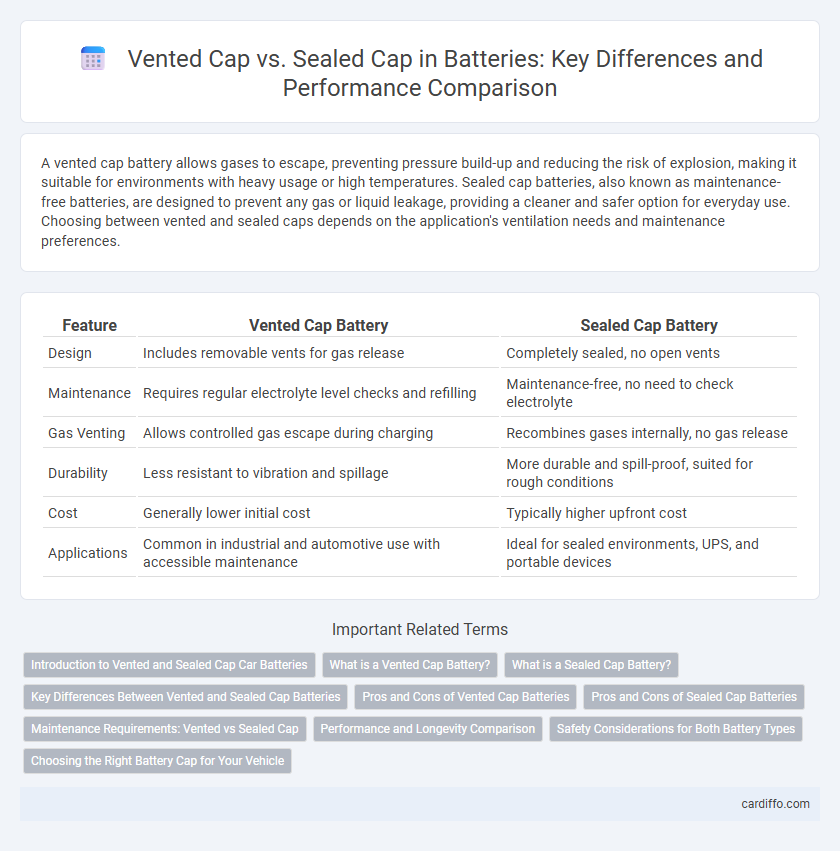A vented cap battery allows gases to escape, preventing pressure build-up and reducing the risk of explosion, making it suitable for environments with heavy usage or high temperatures. Sealed cap batteries, also known as maintenance-free batteries, are designed to prevent any gas or liquid leakage, providing a cleaner and safer option for everyday use. Choosing between vented and sealed caps depends on the application's ventilation needs and maintenance preferences.
Table of Comparison
| Feature | Vented Cap Battery | Sealed Cap Battery |
|---|---|---|
| Design | Includes removable vents for gas release | Completely sealed, no open vents |
| Maintenance | Requires regular electrolyte level checks and refilling | Maintenance-free, no need to check electrolyte |
| Gas Venting | Allows controlled gas escape during charging | Recombines gases internally, no gas release |
| Durability | Less resistant to vibration and spillage | More durable and spill-proof, suited for rough conditions |
| Cost | Generally lower initial cost | Typically higher upfront cost |
| Applications | Common in industrial and automotive use with accessible maintenance | Ideal for sealed environments, UPS, and portable devices |
Introduction to Vented and Sealed Cap Car Batteries
Vented cap car batteries feature removable caps that allow gas to escape during the charging process, helping to prevent pressure buildup and potential damage. Sealed cap batteries, also known as maintenance-free batteries, are designed to trap gases internally and recombine them, reducing water loss and minimizing maintenance requirements. Choosing between vented and sealed cap batteries depends on factors such as vehicle type, usage conditions, and maintenance preferences.
What is a Vented Cap Battery?
A vented cap battery features removable caps that allow gases produced during charging to escape safely, preventing pressure buildup inside the cell. This design facilitates regular maintenance, such as topping up electrolyte levels, enhancing the battery's longevity and performance. Commonly used in automotive and industrial applications, vented cap batteries require proper handling to avoid acid spills and ensure efficient ventilation.
What is a Sealed Cap Battery?
A sealed cap battery is a type of lead-acid battery designed without removable vent caps, preventing electrolyte leakage and reducing maintenance requirements. It uses a valve-regulated design that allows gases to recombine internally, ensuring safer operation and longer life compared to vented cap batteries. Sealed cap batteries are widely used in applications like uninterruptible power supplies (UPS), emergency lighting, and portable electronics due to their spill-proof and low-maintenance characteristics.
Key Differences Between Vented and Sealed Cap Batteries
Vented cap batteries have removable caps that allow gas to escape during charging, preventing pressure buildup and reducing the risk of explosion, while sealed cap batteries are designed to be maintenance-free and contain internal valves that recombine gases, minimizing electrolyte loss. Vented batteries require periodic water top-ups to maintain electrolyte levels, whereas sealed batteries do not require this maintenance, making them more convenient for users. The choice between vented and sealed cap batteries impacts safety, maintenance frequency, and application suitability in automotive and industrial contexts.
Pros and Cons of Vented Cap Batteries
Vented cap batteries offer the advantage of pressure regulation, allowing gases produced during charging to escape, which prevents build-up and potential rupture. These batteries require regular maintenance to check electrolyte levels, posing a risk of spillage and corrosion if neglected. Their design typically results in better heat dissipation and longer service life under high-load conditions compared to sealed cap batteries.
Pros and Cons of Sealed Cap Batteries
Sealed cap batteries offer enhanced spill resistance and reduced maintenance compared to vented cap batteries, making them ideal for applications where safety and convenience are priorities. Their design minimizes electrolyte evaporation and contamination, leading to longer service life and consistent performance. However, sealed cap batteries can have limited gas release capabilities, which may cause pressure buildup under extreme conditions and restrict their use in high-drain or heavily ventilated environments.
Maintenance Requirements: Vented vs Sealed Cap
Vented cap batteries require regular maintenance, including checking electrolyte levels and topping up with distilled water to prevent damage from evaporation. Sealed cap batteries are maintenance-free, as they are designed to recombine gases internally, eliminating the need for electrolyte checks or refills. This difference significantly impacts the long-term cost and convenience of battery upkeep.
Performance and Longevity Comparison
Vented cap batteries excel in heat dissipation and pressure regulation, reducing the risk of explosion and enhancing safety during high-performance usage. Sealed cap batteries offer superior resistance to leakage and require less maintenance, which contributes to longer service life in sealed environments. Performance-wise, vented cap batteries provide better electrical output under heavy loads, while sealed cap batteries ensure consistent longevity through controlled internal conditions.
Safety Considerations for Both Battery Types
Vented caps on batteries allow gas to escape, reducing the risk of pressure buildup and explosions but require proper ventilation to prevent hydrogen gas accumulation. Sealed caps are designed to prevent leaks and contamination, enhancing safety in enclosed environments but pose a risk if pressure exceeds design limits due to gas buildup. Proper maintenance and monitoring are critical for both vented and sealed battery caps to ensure safe operation and prevent hazardous conditions.
Choosing the Right Battery Cap for Your Vehicle
Choosing the right battery cap depends on your vehicle's maintenance needs and operating conditions. Vented caps allow gases to escape, preventing pressure buildup in batteries used in high-temperature or high-demand environments, while sealed caps require no maintenance and reduce the risk of acid leaks, ideal for sealed or maintenance-free batteries. Assessing your vehicle's usage, climate, and manufacturer recommendations ensures optimal battery performance and longevity.
Vented Cap vs Sealed Cap Infographic

 cardiffo.com
cardiffo.com